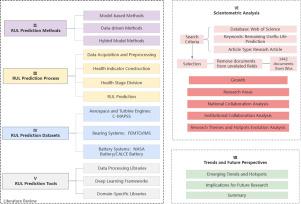剩余使用寿命预测的全面概述:从传统文献综述到科学计量分析
IF 4.9
引用次数: 0
摘要
工业系统日益复杂,提高了对精确剩余使用寿命(RUL)预测的需求。本文提供了RUL预测方法、过程、数据集和工具的全面概述,以及科学计量学分析的见解。我们将规则规则预测方法分为基于模型的方法、数据驱动的方法和混合方法,并详细介绍了关键模型及其应用。基于模型的方法利用物理失效机制,增强了可解释性,但对复杂系统的适应性有限。数据驱动的方法使用机器学习来扩展数据集,提高了适应性,但往往以可解释性为代价。混合方法旨在在这些优势之间取得平衡,在各种应用中提供准确性和灵活性。此外,我们概述了从数据采集到实现的RUL预测过程,并介绍了用于发动机,轴承和电池研究的主要数据集以及常用的编程框架和开源库。我们还对Web of Science数据库中的3442篇文章进行了科学计量学分析,检查了研究领域、著名研究小组和新兴趋势。我们的研究结果提供了RUL预测领域的全面概述,概述了其当前趋势并突出了未来研究的潜在方向。本文章由计算机程序翻译,如有差异,请以英文原文为准。

A comprehensive overview of remaining useful life prediction: From traditional literature review to scientometric analysis
The increasing complexity of industrial systems has heightened the need for precise Remaining Useful Life (RUL) predictions. This paper provides a comprehensive overview of RUL prediction methods, processes, datasets, and tools, alongside insights from scientometric analysis. We categorize RUL prediction methods into model-based, data-driven, and hybrid methods, detailing key models and their applications. Model-based methods utilize physical failure mechanisms, enhancing interpretability, but with limited adaptability for complex systems. Data-driven methods use machine learning to extensive datasets, boosting adaptability but often at the cost of explainability. Hybrid methods aim to strike a balance between these strengths, offering both accuracy and flexibility across various applications. In addition, we outline the RUL prediction process, from data acquisition to implementation, and introduce the primary datasets used in studies of engines, bearings, and batteries as well as commonly used programming frameworks and open-source libraries. We also performed a scientometric analysis of 3442 articles from the Web of Science database, examining research areas, prominent research groups, and emerging trends. Our findings offer a comprehensive overview of the RUL prediction field, outlining its current trends and highlighting potential directions for future research.
求助全文
通过发布文献求助,成功后即可免费获取论文全文。
去求助
来源期刊

Machine learning with applications
Management Science and Operations Research, Artificial Intelligence, Computer Science Applications
自引率
0.00%
发文量
0
审稿时长
98 days
 求助内容:
求助内容: 应助结果提醒方式:
应助结果提醒方式:


